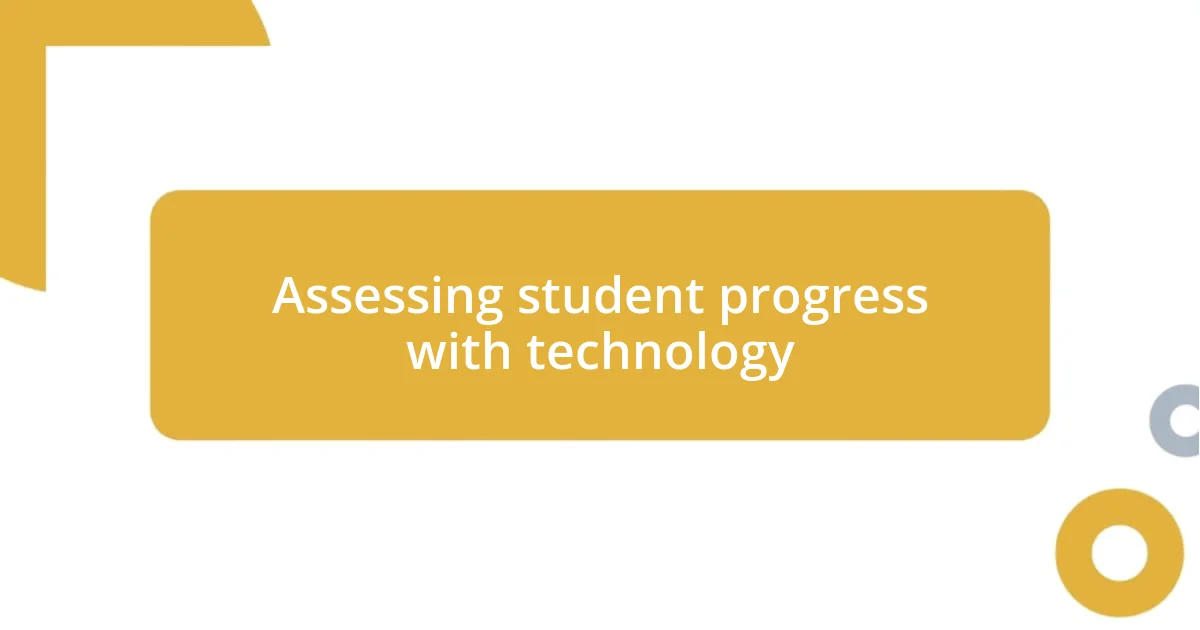Key takeaways:
- Technology enhances student engagement and collaboration, transforming traditional learning and allowing students to connect and contribute effectively.
- Identifying individual student needs through ongoing dialogue and personalized learning plans fosters a sense of ownership and boosts confidence in their educational journey.
- Continuous reflection and adaptation of technology usage in the classroom, including gathering student feedback, are essential for enhancing the learning experience and ensuring effective tech integration.

Understanding technology in education
Understanding technology in education means recognizing its potential to transform traditional learning experiences. I vividly recall a time when a student of mine, initially disengaged and hesitant, blossomed through the use of interactive apps that brought the curriculum to life. Isn’t it fascinating how a simple tool can spark such enthusiasm in learning?
Moreover, technology in the classroom fosters collaboration among students in ways I never thought possible. I once witnessed a group project where students communicated through a shared digital platform, allowing each member to contribute from wherever they were. This made me question: how many more voices could be heard if every student had equal access to these tech tools?
As I’ve observed, understanding technology also involves navigating its challenges. For instance, while some students thrive with digital resources, others may struggle, either due to lack of familiarity or access. I wonder, how can we bridge that gap and ensure that every student benefits equally from these educational advancements?

Identifying student needs and goals
Identifying student needs and goals is a critical step in leveraging technology to enrich the educational experience. I remember sitting down with a student who was anxious about taking advanced math courses. By using customized online assessments, we discovered her strengths and weaknesses, allowing us to create a personalized learning plan. This not only alleviated her anxiety but also set clear, achievable goals, which invigorated her entire learning journey.
In my experience, understanding students’ specific needs requires more than mere observation; it demands active listening and empathy. During a tech workshop, I noticed a combination of excitement and confusion among my students when faced with a new software tool. Taking a moment to gather their feedback revealed that while some were eager to dive into complex features, others needed simpler starting points. Responding to this variety in experience helped us tailor our approach, ensuring each student felt supported.
The process of identifying needs and goals doesn’t stop at initial assessments; it evolves as students grow. I often check in with my students every few weeks to discuss their progress and any evolving goals. This ongoing dialogue not only helps them stay on track but also instills a sense of ownership over their learning. It’s rewarding to see them light up when they reach milestones, reinforcing the idea that technology, when aligned with their unique goals, can be a powerful ally in their education.
| Need | Goal |
|---|---|
| Struggling with advanced concepts | Gain confidence and mastery |
| High anxiety regarding projects | Develop project management skills |
| Varied tech familiarity | Equal access and support |

Choosing the right tech tools
Choosing the right tech tools can feel overwhelming, but my approach is always to focus on what resonates with my students. Recently, I trialed several educational apps in my classroom, sharing them during a brainstorming session where every student had a voice. The excitement was palpable as they eagerly suggested their favorites, each tool sparking a conversation about their potential and relevance. This collaborative atmosphere made choosing the right tools not just a decision, but a shared journey that deepened their investment in the learning process.
When evaluating tech tools, I often consider a few essential factors:
- User-friendliness: Is the tool intuitive enough for all students, regardless of their tech-savviness?
- Engagement: Does it foster interest and interaction, encouraging students to participate actively?
- Accessibility: Can it be used on various devices, ensuring all students have equal access?
- Feedback Mechanism: Does it provide real-time feedback to guide students in their learning paths?
- Adaptability: Can the tool be tailored to fit diverse learning styles and objectives?
By taking these aspects into account, I feel more confident in nurturing a tech-rich environment that empowers every student to thrive.

Integrating technology into lessons
Integrating technology into lessons opens a world of possibilities in the classroom. I vividly recall a moment during a science class when I introduced an interactive simulation tool. Watching my students manipulate variables to see real-time changes in a virtual environment was exhilarating. It was as if an invisible barrier broke down, and those who usually held back began asking questions and sharing ideas with newfound enthusiasm.
A critical aspect of my approach is ensuring that technology aligns seamlessly with the curriculum. I once designed a history project utilizing a collaborative platform where students could create digital timelines. As they pieced together events and interlinked them visually, I was amazed at how this technological integration deepened their understanding. I asked them, “How does seeing history unfold visually change your perspective on it?” Their thoughtful responses highlighted the power of technology to engage and provoke critical thinking.
Moreover, I’ve found that incorporating tech does more than just enhance lessons; it fosters a sense of community among students. For instance, I remember a group of students collaborating on a presentation using multimedia tools. They were not only learning the content but also developing essential teamwork skills! Seeing them problem-solve together and share feedback reminded me of the beauty of collective learning. It’s moments like these that affirm my belief in technology as more than a teaching aid—it’s a bridge to deeper connections and richer experiences in education.

Encouraging collaboration and communication
There’s something truly magical about witnessing students come together to tackle a project, and technology can amplify that experience. I once facilitated a collaborative writing project using a shared document platform. It was amazing to watch as students left comments and critiques for each other in real-time, transforming the writing process into a dialogue rather than a solo endeavor. I remember one student, usually quiet, wrote, “I never thought my ideas could inspire others!” It struck me how empowering this technology was; it gave them a voice and a platform to shine.
One of my favorite tools for fostering conversations is an online discussion board. I encouraged my students to post their thoughts on a topic, and I was pleasantly surprised by the depth of engagement that unfolded. It became a space where they could express themselves freely, and I observed them building on each other’s ideas. I often wonder, how often do we create those spaces in our education? The beauty of this platform is not just in sharing opinions; it cultivates an environment where students feel safe to challenge and support one another.
Beyond the technical aspects, I firmly believe that collaboration and communication through technology nurture essential life skills. I recall a group project where students divided tasks using a project management app. It was an invaluable lesson in responsibility and teamwork. When the project was completed, one student remarked, “We really felt like a team; it was awesome to know we all contributed.” Moments like these remind me that encouraging collaboration using tech isn’t just about academic achievement; it’s about shaping empathetic and communicative future leaders.

Assessing student progress with technology
Assessing student progress with technology has transformed the way I view evaluation. Recently, I began using an adaptive learning platform that adjusts content based on individual student performance. Watching students engage with tailored lessons made me wonder: how much more will technology personalize learning? I saw one student, who had previously struggled with math, lighting up as the system offered challenges perfectly suited to their level. It was a revelation for me—proving that technology can truly meet students where they are.
I also love utilizing online quizzes and formative assessments to gauge understanding in real-time. During a lesson on literary analysis, I launched a live polling tool where students could answer comprehension questions as they read. The instant feedback allowed me to identify which concepts were hitting home and which needed more attention. One student even shared, “I appreciate knowing I’m on the right track! It boosts my confidence.” That immediate reassurance can be a game-changer for learners, illuminating paths for growth that might have otherwise gone unnoticed.
Furthermore, I value how technology fosters continuous dialogue about progress. By incorporating e-portfolios, students can reflect on their learning journeys and showcase their best work. One student recently told me, “It’s nice to see how far I’ve come!” This sense of ownership over their progress is powerful. It made me realize that assessment isn’t just about grades—it’s about nurturing self-awareness and growth. How can we harness these tools further to empower students in their learning? It’s a question I continually explore, and I genuinely believe that the journey of assessment through technology will only evolve and expand in exciting ways.

Continuously improving tech usage
I’ve found that continuously improving tech usage in the classroom is a dynamic process that keeps both students and me on our toes. I recall tweaking my use of an educational app after noticing some students were overwhelmed by its features. A simple adjustment to break tasks into smaller, bite-sized challenges not only eased their anxiety but also led to more engagement. Isn’t it fascinating how a minor change in approach can lead to significant growth?
Moreover, I often engage in reflection after lessons, asking myself how tech tools impacted student learning. For instance, during a science project, I integrated a simulation software that allowed students to experiment virtually. After noticing their excited reactions, I realized that they not only grasped complex concepts more effectively but also expressed a newfound curiosity. This made me wonder: how can we capture that energy and extend it beyond the lesson?
I’ve come to appreciate the importance of seeking feedback from my students about their tech experiences. One time, I conducted a quick survey after finishing a unit, and the insights were eye-opening. A few students suggested incorporating gamified elements to increase motivation, and I thought, why not? Their voice in shaping our tech usage is invaluable; it makes the learning process more collaborative and ensures that I’m not just using technology for the sake of it, but truly enhancing their educational journey.













